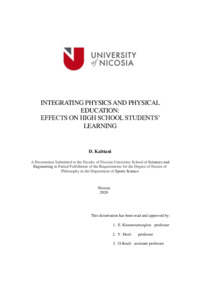- Kaittani, Despina
- School of Sciences and Engineering
- 2021
- English
- 208 pages
- Kioumourtzoglou, Efthymis | Derri, Vasiliki | Kouli, Olga
- Interdisciplinary | Physical Education | Physics
- Social science -- Sports Science
-
-
The interdisciplinary approach has risen in the modern curricula as it is considered an important and challenging technique. Integrating core subjects with physical activity can be very beneficial to student learners in all levels of Education. This research not only includes contributions from different disciplines, but also focuses on theoretical work and empirical evidence from Physics and Physical Education, in an attempt to identify how the method of interdisciplinary within the teaching and learning process between Physics and Physical Education could be effective in student learning. Specifically, the purpose of the present study was to investigate how the interdisciplinary approach between Physics and Physical Education could improve high school students’ conceptual understanding in the field of “Forces”; stretch, friction/stopping distance, air resistance, up thrust, and weight, as well as performance in P.E.: transfer of ball, air resistance, flexibility, aerobic exercise, energy balance/Body Mass Index. A total of 147 hypotheses were examined. Hypotheses 1 to 83 examined each individual question of PHYSICS knowledge test, while Hypotheses 94 to 123 examined the question groups belonging to each PHYSICS subtopic. Hypotheses 84 to 93 and 114 to 133 were focused on P.E. fields test activities. Hypotheses 134 to 147 involved the aggregation of all question variables for PHYSICS and P.E. to assess the potential impact of group and gender variables on each.
The entire experimental project, on which the empirical quantitative research was based, lasted 16 weeks, and was carried out in three private schools located in different regions around Cyprus and owned by the same company. It involved a particular sample of 180 7th-grade 13-year-old students equally divided into two groups: the experimental (n=90) and the control group (n=90). The specific age group was selected because of the same background that the children had in elementary schools. During this period, an 80-minute teaching period was dedicated twice a week on Physics and once a week on Physical Education. The experimental group went through the procedure of the interdisciplinary learning, according to which Physics was taught through examples and activities of Physical Education and vice versa. On the contrary, the control group followed the default syllabus.
For the evaluation of cognitive understanding in Physics a questionnaire was created with 5 factors representing the five subtopics, and 50 questions. Through the process of performing a reliability test and calculating the difficulty and discrimination indices, 39 questions remained in the final version of the questionnaire of Physics knowledge test. On the other hand, for the evaluation of performance in Physical Education, a test was given to students, involving five multiple choice questions, which also required answer justification.
Several statistical methods and tests, including correlations, cross-tabulation, t-tests and three-way repeated measures General Linear Model (GLM) were used for data analysis. Based on the results, there was a significant improvement in the experimental group students’ performance and understanding between “pre” and “post” phases of the trial, regarding 32 out of 42 questions in the Physics Knowledge Test. A distinctive examination of students’ overall performance in each Physics subtopic per test group (experimental – control) and per trial phase (pre – post) showed that the experimental group students significantly outperformed the control group students in subtopics 1 – 4, regarding “Friction/Stopping Distance”, “Air Resistance”, “Up Thrust” and “Stretch”, while there was no significant difference between the two groups in subtopic 5 regarding “Weight/Gravity”. On the other hand, in the post-trial test, students from the experimental group had a significantly better overall performance in all five subtopics. The same conclusion was reached when investigating the impact of group on the overall performance of students in the Physics’ topic of Forces. In other words, experimental group students had a significantly more improved overall performance than control group students in the Physics’ topic of Forces. Also, the experimental group had a significantly better improvement than the control group in the P.E. subtopics “Transfer of the Ball” and “Air Resistance”, and “Energy Balance/Body Mass Index”. On the contrary, there was no significant difference between the performances of two genders in any of the disciplines’ subtopics, in any measure.
It seems that through the interdisciplinary approach, more clear processes and rules are attained, favoring the real understanding and consolidation of notions which often remain more vague when delivered in a "traditional learning environment".
-
Integrating physics and physical education: effects on high school students’ learning
Main Files
| Type | Location | Link |
|---|---|---|
| dissertation | [More information] |


